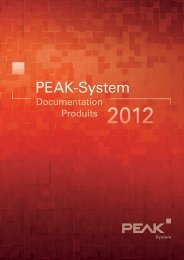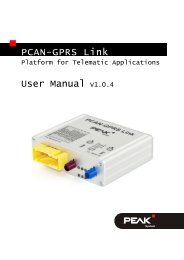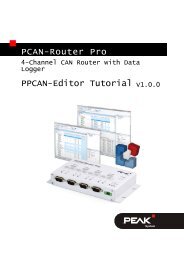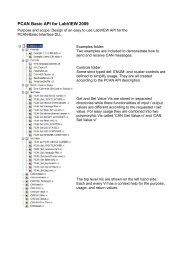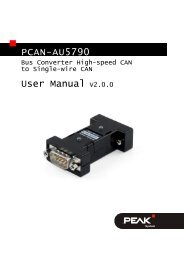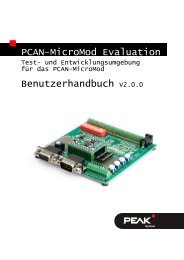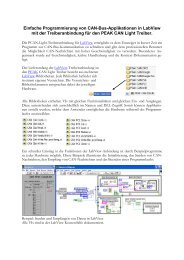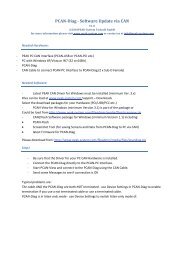PCAN-MicroMod Mix 1 - User Manual - PEAK-System
PCAN-MicroMod Mix 1 - User Manual - PEAK-System
PCAN-MicroMod Mix 1 - User Manual - PEAK-System
Create successful ePaper yourself
Turn your PDF publications into a flip-book with our unique Google optimized e-Paper software.
<strong>PCAN</strong>-<strong>MicroMod</strong> <strong>Mix</strong> 1<br />
Application-specific <strong>PCAN</strong>-<strong>MicroMod</strong><br />
Motherboard<br />
<strong>User</strong> <strong>Manual</strong> V1.10.0
<strong>PCAN</strong>-<strong>MicroMod</strong> <strong>Mix</strong> 1 – <strong>User</strong> <strong>Manual</strong><br />
Products taken into account<br />
Product Name Model Part number<br />
<strong>PCAN</strong>-<strong>MicroMod</strong> <strong>Mix</strong> 1 Including casing and<br />
<strong>PCAN</strong>-<strong>MicroMod</strong><br />
IPEH-002202<br />
CANopen® and CiA® are registered community trade marks of CAN in Automation<br />
e.V.<br />
All other product names mentioned in this document may be the trademarks or<br />
registered trademarks of their respective companies. They are not explicitly marked<br />
by “” and “®”.<br />
© 2012 <strong>PEAK</strong>-<strong>System</strong> Technik GmbH<br />
<strong>PEAK</strong>-<strong>System</strong> Technik GmbH<br />
Otto-Roehm-Strasse 69<br />
64293 Darmstadt<br />
Germany<br />
Phone: +49 (0)6151 8173-20<br />
Fax: +49 (0)6151 8173-29<br />
www.peak-system.com<br />
info@peak-system.com<br />
Document version 1.10.0 (2012-05-08)<br />
2
<strong>PCAN</strong>-<strong>MicroMod</strong> <strong>Mix</strong> 1 – <strong>User</strong> <strong>Manual</strong><br />
Contents<br />
1 Introduction 4<br />
1.1 Properties at a Glance 4<br />
1.2 Prerequisites for Operation 5<br />
1.3 Scope of Supply 6<br />
2 Hardware Configuration 7<br />
2.1 Modification on Nominal Supply Voltages ><br />
12 V 8<br />
2.2 Pull-up/Pull-down Circuits for the Digital<br />
Inputs 9<br />
2.3 Measuring Range Extension of the Analog<br />
Inputs 11<br />
3 Operation 12<br />
3.1 Port Assignment 12<br />
3.2 Configuration Program 13<br />
3.2.1 <strong>System</strong> Prerequisites 13<br />
3.2.2 Installing the Program 14<br />
3.2.3 Creating a Configuration 14<br />
3.2.4 Applicable <strong>MicroMod</strong> Services 15<br />
3.3 Status LEDs 16<br />
3.4 Several <strong>MicroMod</strong>s on the CAN Bus 16<br />
4 Technical Specifications 18<br />
Appendix A CE Certificate 21<br />
Appendix B Dimension Drawing 22<br />
3
<strong>PCAN</strong>-<strong>MicroMod</strong> <strong>Mix</strong> 1 – <strong>User</strong> <strong>Manual</strong><br />
1 Introduction<br />
The motherboards for <strong>PCAN</strong>-<strong>MicroMod</strong> provide an applicationoriented<br />
environment. Typical characteristics of this product group<br />
include a wide supply voltage range and the protective circuit for<br />
the inputs and outputs. CANopen® firmware is available for all<br />
<strong>PCAN</strong>-<strong>MicroMod</strong> motherboards.<br />
The <strong>Mix</strong> 1 motherboard serves common analog and digital requirements<br />
and supports temperature measurement.<br />
Note: This manual only refers to the motherboard as base for a<br />
<strong>PCAN</strong>-<strong>MicroMod</strong> and to the standard firmware. For the <strong>PCAN</strong>-<br />
<strong>MicroMod</strong> and the configuration program <strong>PCAN</strong>-<strong>MicroMod</strong><br />
Configuration, there is separate documentation.<br />
1.1 Properties at a Glance<br />
Completely configurable using the Windows program <strong>PCAN</strong>-<br />
<strong>MicroMod</strong> Configuration<br />
Communication through High-speed CAN (ISO 11898-2)<br />
Operating voltage 8 to 26 V<br />
Aluminum profile casing with spring terminal connectors<br />
Top hat rail mounting option available<br />
Extended operating temperature range from -40 to +85 °C<br />
(-40 to +185 °F)<br />
4
<strong>PCAN</strong>-<strong>MicroMod</strong> <strong>Mix</strong> 1 – <strong>User</strong> <strong>Manual</strong><br />
6 digital inputs:<br />
• Pull-up or pull-down circuit selectable (in 3 groups)<br />
• High state at 5 to 18 V input voltage<br />
• Schmitt trigger behavior, inverting<br />
• Low-pass behavior<br />
• Parallel connection of a frequency input (for each digital<br />
input 0 to 3) for alternative use (e.g. fast status changes,<br />
countings)<br />
2 temperature inputs for connection of thermistors (type<br />
EC95F103W), measuring range 0 to 70 °C (32 to 158 °F)<br />
2 analog inputs:<br />
• Pull-down circuit<br />
• Measuring range unipolar, 0 to 5 V<br />
• Measuring range extension possible<br />
• Protection against undervoltage and overvoltage<br />
2 digital/frequency outputs:<br />
• Fast low-side switches, max. 55 V, 0.75 A<br />
• Short circuit protection<br />
Status LEDs for power supply and digital output<br />
1.2 Prerequisites for Operation<br />
Power supply in the range of 8 to 26 V DC<br />
For creating and transferring configurations: computer with<br />
Windows 7/Vista/XP (32-bit or 64-bit) and a CAN interface from<br />
the <strong>PCAN</strong> series<br />
5
<strong>PCAN</strong>-<strong>MicroMod</strong> <strong>Mix</strong> 1 – <strong>User</strong> <strong>Manual</strong><br />
1.3 Scope of Supply<br />
<strong>PCAN</strong>-<strong>MicroMod</strong><br />
<strong>PCAN</strong>-<strong>MicroMod</strong> motherboard in casing including mating<br />
connectors<br />
<strong>PCAN</strong>-<strong>MicroMod</strong> Configuration for Windows<br />
<strong>Manual</strong> in PDF format<br />
6
<strong>PCAN</strong>-<strong>MicroMod</strong> <strong>Mix</strong> 1 – <strong>User</strong> <strong>Manual</strong><br />
2 Hardware Configuration<br />
You can customize the motherboard by modifying the hardware.<br />
The following subsections contain descriptions about possible<br />
modifications.<br />
Accessing the Motherboard<br />
In order to carry out the modifications described in the following<br />
sections, unscrew the lid of the casing and pull off the <strong>MicroMod</strong><br />
from the motherboard.<br />
Attention! Electrostatic discharge (ESD) can damage or destroy<br />
components on the motherboard or the <strong>PCAN</strong>-<strong>MicroMod</strong>. Take<br />
precautions to avoid ESD when handling the boards.<br />
Remounting the <strong>MicroMod</strong><br />
When you remount the <strong>MicroMod</strong>, take notice of the white triangular<br />
marks on each the motherboard and the <strong>MicroMod</strong> (upper left<br />
corner). These marks must align.<br />
Figure 1: Positioning of the <strong>MicroMod</strong><br />
7
<strong>PCAN</strong>-<strong>MicroMod</strong> <strong>Mix</strong> 1 – <strong>User</strong> <strong>Manual</strong><br />
2.1 Modification on Nominal Supply<br />
Voltages > 12 V<br />
If you want to supply the <strong>Mix</strong> 1 motherboard with a nominal voltage<br />
+U b > 12 V (usually 24 V), then you must do the following<br />
modification:<br />
1. Equip the unpopulated position D6 with a reference diode<br />
BZV55C12 (package SOD-80).<br />
Figure 2: Position D6 (top side of the PCB)<br />
2. Replace the 0-Ohm resistor on position R33 with a resistor of<br />
1.6 kΩ (package S1206).<br />
8
<strong>PCAN</strong>-<strong>MicroMod</strong> <strong>Mix</strong> 1 – <strong>User</strong> <strong>Manual</strong><br />
Figure 3: Position R33 (bottom side of the PCB)<br />
Note: You do not need to consider voltage fluctuations that<br />
might occur. A modification isn't required in that case. Example:<br />
In the automotive sector up to 18 V may occur at a nominal<br />
voltage of 12 V.<br />
2.2 Pull-up/Pull-down Circuits for the<br />
Digital Inputs<br />
At delivery the digital inputs are set to pull-up circuits. You can set<br />
them to pull-down circuit in groups. This is done by repositioning<br />
resistors.<br />
Digital inputs Pull-up (+Ub) * Pull-down (GND)<br />
DIn 0 R31 (2.7 kΩ) R12 (2.7 kΩ)<br />
DIn 1 and DIn 2 R53 (0 Ω) R55 (0 Ω)<br />
DIn 3 to DIn 5 R54 (0 Ω) R56 (0 Ω)<br />
* Setting at delivery<br />
9
<strong>PCAN</strong>-<strong>MicroMod</strong> <strong>Mix</strong> 1 – <strong>User</strong> <strong>Manual</strong><br />
Figure 4: Positions R31, R53/R55, R54/R56 (top side of the PCB)<br />
Figure 5: Position R12 (bottom side of the PCB)<br />
Attention! Double-check for inadvertent short circuits after<br />
altering the setup, especially at positions R53/R55 and R54/R56.<br />
10
<strong>PCAN</strong>-<strong>MicroMod</strong> <strong>Mix</strong> 1 – <strong>User</strong> <strong>Manual</strong><br />
2.3 Measuring Range Extension of the<br />
Analog Inputs<br />
You can extend the measuring range of each analog input to a<br />
higher maximum voltage than 5 Volts by using a voltage divider. On<br />
delivery of the motherboard the resistor positions R30 and R43 on<br />
the bottom side of the PCB are not equipped. By inserting a resistor<br />
R x (package S0805) with a value calculated with the following formula<br />
the measuring range is extended to the desired maximum<br />
voltage U MB.<br />
2400 Ω<br />
=<br />
UMB<br />
−1<br />
5 V<br />
( U<br />
Rx MB<br />
><br />
5 V)<br />
Analog<br />
input<br />
AIn 2 R30<br />
AIn 3 R43<br />
11<br />
Insert R x<br />
on position<br />
Figure 6: Positions R30 and R43 (bottom side of the PCB)
<strong>PCAN</strong>-<strong>MicroMod</strong> <strong>Mix</strong> 1 – <strong>User</strong> <strong>Manual</strong><br />
3 Operation<br />
3.1 Port Assignment<br />
The motherboard has two connectors, J1/2 on the left and J3 on the<br />
right. The port assignment is as follows:<br />
Figure 7: Ports of the <strong>Mix</strong> 1 motherboard<br />
Port name<br />
J1/2<br />
Function<br />
+Ub Operating voltage 8 - 26 V DC<br />
See also section 2.1 Modification on Nominal Supply<br />
Voltages > 12 V on page 8.<br />
GND Digital ground<br />
CAN_L<br />
CAN_H<br />
Differential CAN signal<br />
N/C Not connected<br />
NTC 0<br />
Connection thermistor<br />
NTC 1<br />
(against AGND)<br />
AIn 2<br />
AIn 3<br />
Analog input<br />
AGND Analog ground<br />
12
<strong>PCAN</strong>-<strong>MicroMod</strong> <strong>Mix</strong> 1 – <strong>User</strong> <strong>Manual</strong><br />
Port name<br />
J3<br />
GND<br />
GND<br />
FOut 2<br />
FOut 0<br />
DIn 5<br />
DIn 4<br />
DIn 3<br />
DIn 2<br />
DIn 1<br />
DIn 0<br />
Function<br />
Digital ground<br />
Frequency output<br />
Digital input<br />
Digital input, frequency input parallel<br />
3.2 Configuration Program<br />
In order to create and transfer <strong>MicroMod</strong> configurations the Windows<br />
software <strong>PCAN</strong>-<strong>MicroMod</strong> Configuration is used. This section<br />
covers basic points about installation and use of the program with<br />
the <strong>Mix</strong> 1 motherboard.<br />
You'll find detailed information about the use of <strong>PCAN</strong>-<strong>MicroMod</strong><br />
Configuration in the related documentation which is invoked via the<br />
program (e.g. with F1).<br />
3.2.1 <strong>System</strong> Prerequisites<br />
Windows 7/Vista/XP (32-bit or 64-bit)<br />
Computer with CAN interface of the <strong>PCAN</strong> series (for transferring<br />
a configuration to the <strong>PCAN</strong>-<strong>MicroMod</strong> via CAN)<br />
13
<strong>PCAN</strong>-<strong>MicroMod</strong> <strong>Mix</strong> 1 – <strong>User</strong> <strong>Manual</strong><br />
3.2.2 Installing the Program<br />
Under Windows install the program from the supplied CD. Start the<br />
corresponding installation routine by using the CD navigation going<br />
to Tools > <strong>PCAN</strong>-<strong>MicroMod</strong> Configuration 2.x.x.<br />
3.2.3 Creating a Configuration<br />
When you start creating a new configuration in <strong>PCAN</strong>-<strong>MicroMod</strong><br />
Configuration, the Board Type dialog box appears in order to select<br />
the type of the used motherboard. The necessary settings are<br />
explained in the following.<br />
Figure 8: <strong>PCAN</strong>-<strong>MicroMod</strong> Configuration: selection of the <strong>Mix</strong> 1 motherboard<br />
Board Type: <strong>PCAN</strong>-<strong>MicroMod</strong> <strong>Mix</strong> 1<br />
Module No: 0<br />
The module number of the <strong>MicroMod</strong> on the <strong>Mix</strong> 1 motherboard is<br />
set to 0 at delivery and is relevant if you want to configure more<br />
than one <strong>MicroMod</strong> on the same CAN bus. See also section 3.4<br />
Several <strong>MicroMod</strong>s on the CAN Bus on page 16.<br />
14
<strong>PCAN</strong>-<strong>MicroMod</strong> <strong>Mix</strong> 1 – <strong>User</strong> <strong>Manual</strong><br />
Baudrate <strong>MicroMod</strong>: 500 kbit/s<br />
At delivery the <strong>MicroMod</strong> is set to a bit rate of 500 kbit/s. A change<br />
of this setting will take effect after sending the completed configuration<br />
to the <strong>MicroMod</strong>.<br />
Note: For the first transfer of a configuration to the module it<br />
must be integrated in a CAN network with a bit rate of<br />
500 kbit/s.<br />
3.2.4 Applicable <strong>MicroMod</strong> Services<br />
The motherboard's inputs and outputs are controlled by the services<br />
of the <strong>MicroMod</strong>. The following table shows the assignment of<br />
the motherboard functions to the <strong>MicroMod</strong> services.<br />
Function on motherboard Port name Access with <strong>MicroMod</strong> service(s)<br />
Digital input DIn 0 … DIn 5<br />
Digital Input<br />
Frequency input (parallel to<br />
channels DI 0 to DI 3)<br />
Temperature measurement NTC 0, NTC 1<br />
(input values are antiproportional<br />
to the<br />
temperature)<br />
Analog input AIn 2, AIn 3<br />
Frequency output (for FOut 0, FOut 2<br />
higher-frequency status<br />
changes)<br />
LED DOut 7 DOut 7<br />
15<br />
Digital Function<br />
Rotary Encoder<br />
Frequency Input<br />
Analog Input<br />
Curve<br />
Analog Input<br />
Curve<br />
Analog Hysteresis<br />
PWM and Frequency Output<br />
Digital Output
<strong>PCAN</strong>-<strong>MicroMod</strong> <strong>Mix</strong> 1 – <strong>User</strong> <strong>Manual</strong><br />
3.3 Status LEDs<br />
The motherboard including the <strong>MicroMod</strong> has three LEDs with the<br />
following status indications:<br />
LED Indication<br />
Power (green) Power is applied.<br />
DOut 7 (red) Is linked to the digital output DO 7 of the <strong>MicroMod</strong> and<br />
can be configured freely.<br />
Activity (red) Status of the <strong>PCAN</strong>-<strong>MicroMod</strong>:<br />
blinking at 1 Hz normal operation<br />
blinking at 2 Hz invalid or no configuration<br />
blinking at 5 Hz configuration mode<br />
continuously on internal <strong>MicroMod</strong> error<br />
3.4 Several <strong>MicroMod</strong>s on the CAN Bus<br />
If you want to use several <strong>MicroMod</strong>s on the same CAN bus and<br />
want to configure them, each one needs its own module number.<br />
That way the <strong>MicroMod</strong>s are distinguishable for the program <strong>PCAN</strong>-<br />
<strong>MicroMod</strong> Configuration.<br />
The module number is set on the <strong>MicroMod</strong> by solder jumpers and<br />
lies in the range of 0 to 31. At delivery each <strong>MicroMod</strong> has the<br />
module number 0.<br />
During normal operation of the <strong>PCAN</strong>-<strong>MicroMod</strong>, the module<br />
number has no effect on the CAN communication.<br />
For setting the solder jumpers on the <strong>MicroMod</strong> unscrew the top of<br />
the casing and remove the <strong>MicroMod</strong> from the motherboard. Please<br />
find further information about the assignment of module numbers<br />
in the separate manual for the <strong>PCAN</strong>-<strong>MicroMod</strong>.<br />
16
<strong>PCAN</strong>-<strong>MicroMod</strong> <strong>Mix</strong> 1 – <strong>User</strong> <strong>Manual</strong><br />
Attention! Electrostatic discharge (ESD) can damage or destroy<br />
components on the motherboard or the <strong>PCAN</strong>-<strong>MicroMod</strong>. Take<br />
precautions to avoid ESD when handling the boards.<br />
Remounting the <strong>MicroMod</strong><br />
When you remount the <strong>MicroMod</strong>, take notice of the white triangular<br />
marks on each the motherboard and the <strong>MicroMod</strong> (upper left<br />
corner). These marks must align.<br />
Figure 9: Positioning of the <strong>MicroMod</strong><br />
17
<strong>PCAN</strong>-<strong>MicroMod</strong> <strong>Mix</strong> 1 – <strong>User</strong> <strong>Manual</strong><br />
4 Technical Specifications<br />
Power supply<br />
Operating voltage +Ub 8 - 26 V DC (±5 %)<br />
Current consumption max. 200 mA, typ. 35 mA at 12 V w/o load<br />
Ripple 5 V < 50 mV (Ub = 12 V, 200 mA load)<br />
Ripple analog < 20 mV<br />
Reverse-polarity protection extant; can get ineffective by the wiring with other<br />
CAN nodes (danger of destruction of electronic<br />
components)<br />
Digital inputs<br />
Count 6<br />
Switching thresholds UIH = 4 V; UIL = 3 V, contact or logic level<br />
Input impedance 2.7 kΩ<br />
Open input Pull-up, optionally pull-down (in groups)<br />
Overvoltage protection extant<br />
Low-pass fg = 7 kHz<br />
Special feature Frequency inputs of the <strong>PCAN</strong>-<strong>MicroMod</strong> parallel<br />
(only DIn 0 to DIn 3)<br />
Digital/frequency outputs<br />
Count 2<br />
Type Low-side<br />
Voltage proof < 55 V<br />
Output current 0.75 A (constant current)<br />
Short circuit protection extant; short-circuit current: 1.2 A<br />
18
<strong>PCAN</strong>-<strong>MicroMod</strong> <strong>Mix</strong> 1 – <strong>User</strong> <strong>Manual</strong><br />
Analog inputs<br />
Count 2<br />
Measuring range 0 to 5 V, extendable<br />
Resolution 10 bit<br />
Source impedance < 5 kΩ<br />
Overvoltage protection extant<br />
Low-pass fg = 66 Hz<br />
Temperature inputs<br />
Count 2<br />
Reference sensor type Thermistor EC95F103W (e.g. RS Components part no.<br />
151-237, form factor: bead) 1<br />
Measuring range 0 to 70 °C (32 to 158 °F) corresponding 5 to 0 V<br />
(antiproportional) 1<br />
Resolution ±1.0 °C (due to sensor)<br />
CAN<br />
Transmission standard High-speed CAN ISO 11898-2, typ. 500 kbit/s, setup<br />
with <strong>PCAN</strong>-<strong>MicroMod</strong> Configuration (Windows<br />
software)<br />
Termination none<br />
CAN ID reserved for 0x7E7<br />
configuration transfer<br />
Module number at delivery 0<br />
(for configuration transfer)<br />
Peculiarity Interference Immunity<br />
Tests compliant to IEC 61000 and DIN EN 61326<br />
Surge ±500 V (specification industrial sector: ±1 kV) 2<br />
Line-conducted HF<br />
10 Veff (specification: 3 Veff) compatibility<br />
1 Other sensor type and measuring range on request<br />
2 This specification could only be fulfilled with ±500 V due to the available space.<br />
Therefore, the motherboard should be used with a local power supply.<br />
19
<strong>PCAN</strong>-<strong>MicroMod</strong> <strong>Mix</strong> 1 – <strong>User</strong> <strong>Manual</strong><br />
Environment<br />
Operating temperature -40 - +85 °C (-40 - +185 °F)<br />
Temperature for storage -40 - +100 °C (-40 - +212 °F)<br />
and transport<br />
Relative humidity 15 - 90 %, not condensing<br />
Ingress protection<br />
IP20<br />
(IEC 60529)<br />
EMC DIN EN 61326-1:2008-06<br />
EC directive 2004/108/EG<br />
Measures<br />
Casing size (incl.<br />
55 x 68 x 24 mm<br />
connectors)<br />
See also dimension drawing in Appendix B on page<br />
22<br />
Weight 109 g<br />
20
<strong>PCAN</strong>-<strong>MicroMod</strong> <strong>Mix</strong> 1 – <strong>User</strong> <strong>Manual</strong><br />
Appendix A CE Certificate<br />
21
<strong>PCAN</strong>-<strong>MicroMod</strong> <strong>Mix</strong> 1 – <strong>User</strong> <strong>Manual</strong><br />
Appendix B Dimension Drawing<br />
Figure 10: Top view and view of front side with connector. The figure does not show<br />
the actual size of the product.<br />
22



![English - Low Quality [7.2 MB] - PEAK-System](https://img.yumpu.com/5931738/1/184x260/english-low-quality-72-mb-peak-system.jpg?quality=85)
